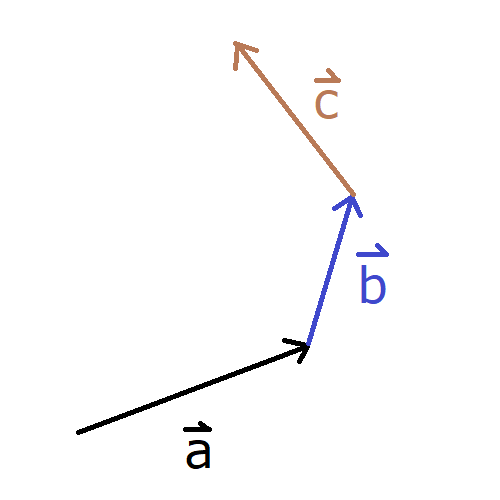The first way we’ll learn to add vectors is graphically.
As we learned in previous units, vectors have a tip (the arrow head) and a tail. When we add vectors we have to add them “tip to tail.” What this means is if you have multiple vectors to add up you simply line them up so that the tip of the first vector is touching the tail of the second vector, and then the tip of the second vector is touching the tail of the third vector, and that pattern just repeats.

Keep in mind that the order you add up vectors doesn’t matter, so you can start with any of the vectors and then just line up the other ones in our tip to tail method.
Traditionally we’d do this on paper using a ruler and a protractor, but since were online we’d might as well make use of the tools available to us and learn to do it digitally (though feel free to practice on paper as well, as it’ll follow the same steps we’re doing digitally).
To do our vector addition we’ll be using a software called Google Drawings, an online tool just like Google Docs and Google Sheets that you’ve likely used in classes before. Watch the video below, that I’ve prepared for you, that will show you how to add vector components graphically using Google Drawings.
In my example the answer, often called the resultant, was straight up and down so it was easy to know the overall length. If your final answer is not straight up and down, simply copy and paste the final answer vector in your diagram and then rotate it the copy so that it is straight up and down. Once it is straight up and down, you’ll be able to get the length of that vector from the height in the side bar. To determine the angle, click on the original resultant vector (not your straight up and down copy) and use the angle it’s pointed at to determine the angle (for example, 25 degrees North of West).
Practice Problems
Complete the following practice problems using the graphical method of vector addition. It would be best to attempt these problems before our Zoom meeting for this section that way if you have any questions you can ask them during our meeting.
- 5 N @ 25° North of West + 3 N @ 5° West of North
- Answer: ~7.9 N @ 72.5° West of North
- 2 N @ 30° East of North + 2 N @ 45° South of West
- Answer: ~0.5 N @ 52.5 West of North
Assignment 1 – Due (Date filled in for actual course to meet the course timeline.)
In our Zoom meeting for this section you will be assigned a group. Find a time that works for you and your group, then meet in an online call and have one group member share a Google Drawing with the other group members using the blue share button in the top right hand corner.
As a group, solve the following three problems on your Google sheet in the same manner I did in my example video.
- 6 N @ 35° North of West + 4 N @ 10° East of South
- 3 N @ 45° East of North + 1 N @ 45° South of West + 2 N North
- 12 N @ 12° North of East + 5 N South
Be sure to specify your north direction and make a text box for each problem stating your final answer.
When your assignment is complete, submit your work to me using the share button in the top right hand corner to share the document with me.
Once you’ve completed all the tasks and learning for this section, please select an option on the Poll.ly form below to let me know how you’re feeling about your understanding of this section. You can cast your vote by clicking the icon beside the answer you want to pick.
https://poll.ly/#/GRMONq9dPlease answer honestly, and don’t be afraid to admit if you’re not understanding as this helps me plan for future sections and if I need to go over certain sections again or in a different way. Votes are anonymous, though it takes your name I’ll only be able to see who participated, not which option you chose.